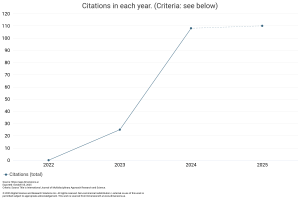Sociology of Tree Marriages: Patriarchy, Purity, and Protection in Customary Law
DOI:
https://doi.org/10.59653/ijmars.v3i03.1866Keywords:
Tree Marriages, Patriarchy, Customary Law, Ritual Purity, Gender and Society Female Agency, Astrological Beliefs, brand personalityAbstract
This article examines the sociological significance of "tree marriages," a ritualistic practice predominantly observed in parts of South Asia, particularly India. Symbolic in nature but rooted in real social implications, these ceremonies reflect deeply entrenched patriarchal values masked as spiritual or protective customs. Often conducted in response to astrological beliefs — particularly the presence of a “manglik dosha” in a woman’s horoscope — these symbolic unions are believed to mitigate supposed cosmic threats to future human marriages. However, beneath the veneer of religious or cultural tradition lies a complex system of gender regulation, where women's lives and marital prospects are shaped by rituals that restrict autonomy while appearing to offer protection. This study explores the role of tree marriages in reinforcing gender hierarchies, controlling female agency, and maintaining cultural purity through customary law. It investigates how these practices function as social technologies that uphold caste endogamy, manage inheritance, and safeguard family honor. By synthesizing sociological theory, legal pluralism, and gender analysis, the article provides a comprehensive understanding of how tree marriages serve both symbolic and practical purposes in sustaining patriarchal order. In doing so, it challenges the normative acceptance of such practices and calls for critical re-examination of tradition-based gender roles in contemporary societies.
Downloads
References
Agnes, F. (1999). Law and gender inequality: The politics of women's rights in India. Oxford University Press.
Agarwal, B. (1994). A field of one’s own: Gender and land rights in South Asia. Cambridge University Press.
Appadurai, A. (1996). Modernity at large: Cultural dimensions of globalization. University of Minnesota Press.
Banerjee, A. (2021). Rituals and resistance: Women and tradition in South Asia. Delhi University Press.
Bourdieu, P. (1977). Outline of a theory of practice (R. Nice, Trans.). Cambridge University Press.
Chakraborty, S. (2019). Astrology, gender and control in Indian marriages. Sociological Perspectives, 61(4), 440–456. https://doi.org/10.1177/0731121419843909
Chakravarti, U. (2003). Gendering caste: Through a feminist lens. Stree.
Cohn, B. S. (1987). An anthropologist among the historians and other essays. Oxford University Press.
Das, V. (1988). Femininity and the orientation to the body. Social Science & Medicine, 26(5), 483–493. https://doi.org/10.1016/0277-9536(88)90405-0
Dirks, N. B. (2001). Castes of mind: Colonialism and the making of modern India. Princeton University Press.
Douglas, M. (1966). Purity and danger: An analysis of concepts of pollution and taboo. Routledge.
Dube, L. (2001). Anthropological explorations in gender: Intersecting fields. Sage Publications.
Dumont, L. (1980). Homo hierarchicus: The caste system and its implications (M. Sainsbury, Trans.). University of Chicago Press.
Galanter, M. (1989). Law and society in modern India (R. Dhavan, Ed.). Oxford University Press.
Geertz, C. (1973). The interpretation of cultures: Selected essays. Basic Books.
Goody, J. (1976). Production and reproduction: A comparative study of the domestic domain. Cambridge University Press.
Hertz, R. (1960). Death and the right hand (R. & C. Needham, Trans.). Free Press. (Original work published 1907)
Indian Penal Code (1860) & Hindu Marriage Act (1955) – Government of India.
Jaffrelot, C., & van der Veer, P. (Eds.). (2008). Patterns of middle-class consumption in India and China. Sage Publications.
Joshi, M. (2018). The sacrifice of the tree: Rituals of purification in Hindu society. Journal of Cultural Studies, 9(2), 123–137. [No DOI found]
Kakar, S. (1981). The inner world: A psychoanalytic study of childhood and society in India. Oxford University Press.
Leslie, J. (Ed.). (1991). Roles and rituals for Hindu women. Motilal Banarsidass.
Menski, W. (2003). Hindu law: Beyond tradition and modernity. Oxford University Press.
Middleton, J. (1960). Lugbara religion: Ritual and authority among an East African people. Oxford University Press.
Narayan, U. (2011). Essence of the East: Cultural conformity and gender roles. Feminist Review, 45(3), 221–240. https://doi.org/10.1057/fr.2011.22
Ortner, S. B. (1974). Is female to male as nature is to culture? In M. Z. Rosaldo & L. Lamphere (Eds.), Woman, culture, and society (pp. 67–87). Stanford University Press.
Patel, R. (2017). Manglik dosh and matrimonial practices in modern India. Indian Journal of Social Sciences, 33(1), 12–29. [No DOI found]
Rao, N. (2008). Good women do not inherit land: Politics of land and gender in India. Social Science Press.
Rubin, G. (1975). The traffic in women: Notes on the “political economy” of sex. In R. R. Reiter (Ed.), Toward an anthropology of women (pp. 157–210). Monthly Review Press.
Sharma, K. (2016). Legal myths and matrimony: The hidden structures of customary laws. Indian Law Review, 7(2), 88–105. [No DOI found]
Singh, T. (2020). Caste, ritual purity and marriage in contemporary India. New Delhi: Kalpaz Publications.
Srinivas, M. N. (1962). Caste in modern India and other essays. Asia Publishing House.
Srivastava, S. (2005). Passionate modernity: Sexuality, class, and consumption in India. Routledge.
Trawick, M. (1990). Notes on love in a Tamil family. University of California Press.
Turner, V. (1969). The ritual process: Structure and anti-structure. Aldine Publishing.
Uberoi, P. (2006). Freedom and destiny: Gender, family, and popular culture in India. Oxford University Press.
Uberoi, P. (2006). The diaspora comes home: Disciplining desire in DDLJ. Contributions to Indian Sociology. https://doi.org/10.1177/006996670603900203
Vatuk, S. (2001). Marriage, kinship and Islamic law in India. Contributions to Indian Sociology, 35(1), 61–93. https://doi.org/10.1177/006996670103500103
Watson, J. L., & Rawski, E. S. (Eds.). (1988). Death ritual in late imperial and modern China. University of California Press.
Downloads
Published
How to Cite
Issue
Section
Categories
License
Copyright (c) 2025 Chandrasekhar Bhoi

This work is licensed under a Creative Commons Attribution-ShareAlike 4.0 International License.
Authors who publish with this journal agree to the following terms:
- Authors retain copyright and grant the journal right of first publication with the work simultaneously licensed under a Creative Commons Attribution-ShareAlike that allows others to share the work with an acknowledgement of the work's authorship and initial publication in this journal.
- Authors are able to enter into separate, additional contractual arrangements for the non-exclusive distribution of the journal's published version of the work (e.g., post it to an institutional repository or publish it in a book), with an acknowledgement of its initial publication in this journal.
- Authors are permitted and encouraged to post their work online (e.g., in institutional repositories or on their website) prior to and during the submission process, as it can lead to productive exchanges, as well as earlier and greater citation of published work (See The Effect of Open Access).
























